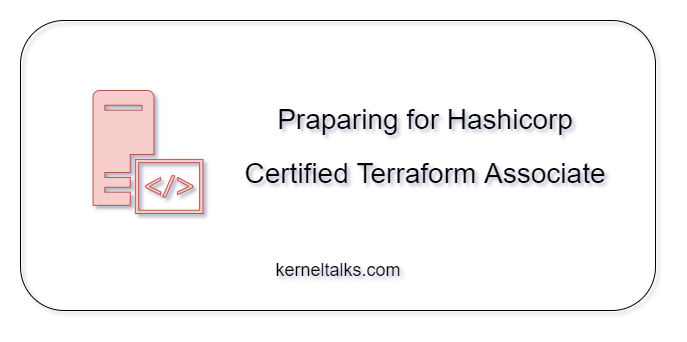A quick article that helps you preparing for Hashicorp Certified Terraform Associate Exam
In this quick post, I would like to share some of the resources that help you clear the terraform associate exam. Feel free to add resources you know in the comments section, which may help fellow readers.
The terraform associate exam is designed to test the candidate’s readiness towards IaC, i.e. Infrastructure as code. IaC concepts, terraform CLI hands-on (a lot of it) and knowledge on terraform’s paid offerings through Cloud or Enterprise should get you through this exam. It’s a practitioner level exam, so it shouldn’t be hard to beat if you have IaC and cloud background.
You must have researched already about the exam on its official page, but here are quick facts for your reference.
- Approx 57-60 questions
- Duration 1 hour
- Validity: 2 years
- Cost: 70.50 USD plus local taxes
- Type: Multiple choice
- It’s online proctored
- Official study guide
- Sample questions
Topics to study
I suggest you have good hands-on with terraform CLI before taking this exam. It will help you cover the majority of topics, and you don’t have to learn them during preparation. That leaves you with minimal topics to prepare for actual certification.
Hashicorp’s study guide is the best resource to follow along for preparation. Let me quickly list down a couple of topics you should not miss during preparation –
- IaC concepts
- Traditional infra provisioning v/s IaC
- Terraform basic workflow
- Write, plan and apply.
- Different types of blocks in terraform code
- Terraform CLI commands (a huge list of them!)
- Terraform Modules, functions, state files
- At least go through all functions once.
- Lots of hands-on to understand how modules works
- State management (a big topic!)
- Debugging and variables
- Different ways to handle variables
- Debugging levels, ways to set them, logging in files
- Detailed understanding of Terraform cloud and enterprise
- Free and paid offerings in each type
- Sentinal, workspaces, remote runs etc. understanding
- Clustering, OS availability in each type
Resources for preparation
Assorted list of online resources you can leverage to follow along your preparation journey.
- Official study guide
- HashiCorp Certified Terraform Associate by A Cloud Guru
- Learning terraform by Linkedin Learning
- Terraform study guide by Ned Bellavance
I am linking here my own last day revision notes as well that I prepared during my certification preparation.
Practice tests
Here is a list of practice tests you can take online before going in for an actual exam. It will test the understanding of your topic and concretes your decision for exam booking.
- HashiCorp Certified: Terraform Associate Practice Exam 2021 on Udemy (Check coupons on author’s Github here. I missed grabbing one 🙁 )
- HashiCorp Certified Terraform Associate by Whizlabs. There is a small free test available too.
- 250 Practice Questions For Terraform Associate Certification on Medium. This list covers a lot of ground.
That’s all I have to share. All the best!
